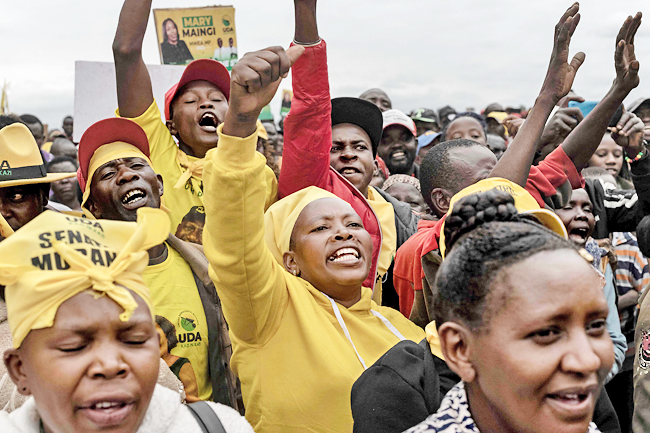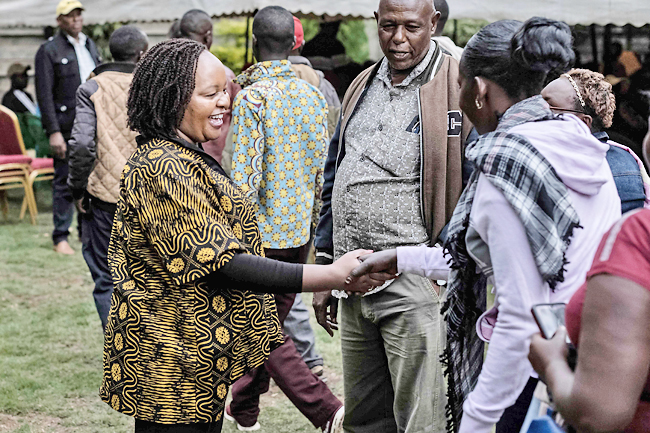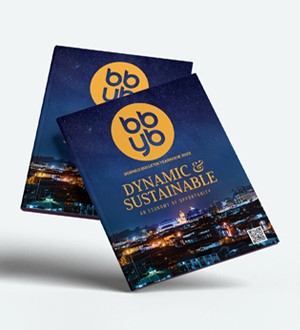KIRINYAGA, KENYA (AFP) – The helicopter lands in the middle of rice fields, heralding the arrival of Kenyan presidential candidate William Ruto as he seeks votes from the densely populated, politically influential heartland of Mount Kenya.
Located in the centre of the country and flanked by an extinct volcano that gives the vast region its name, Mount Kenya has long played a key role in presidential elections and this year is no exception.
As the underdog in the August 9 election, where he will face Raila Odinga, a veteran opposition politician who now has the backing of the ruling Jubilee party, Ruto and his team know that winning Mount Kenya is essential.
The 55-year-old has vowed to lift millions of Kenyans out of poverty, making “bottom-up” economic growth a major plank of his campaign.
At the rally in Kirinyaga country, Nancy Njeri, a 78-year-old rice farmer, told AFP he had her vote.
“Ruto will bring changes in education, youth employment, he will ensure we have fertiliser to grow our rice, and many more things,” she said.


Kirinyaga governor Anne Waiguru predicted a huge victory for Ruto’s United Democratic Alliance (UDA) party in the region, telling AFP that he is “someone who is accepted by the people of Mount Kenya.”
“He has done a lot of groundwork in that regard,” the UDA politician said.
Ruto, a businessman from the Kalenjin tribe who is currently serving as Kenya’s deputy president, was originally slated to succeed President Uhuru Kenyatta.
Instead, he found himself banished to the sidelines after his boss struck a deal with arch-rival Odinga.
Embittered but ambitious, Ruto launched a new party and began laying the foundation for his candidacy, focussing in particular on the region which is perhaps most representative of the complex politics that govern Kenya.
It was a long shot for the Kalenjin leader, at least on paper.
Mount Kenya is the sacred land of the Kikuyu, Kenya’s largest ethnic group, who believe that God lives in the snow-capped volcano they call Kirinyaga.
The fertile region, home to mango orchards and coffee plantations, also occupies a hallowed place in Kenyan history – the Mau Mau rebellion against the British Empire began here in 1952.
“From that time (onwards) there is this sense of entitlement that the Kikuyus have always had,” said analyst Herman Manyora, who favours Odinga.
Nearly six decades after independence in 1963, Mount Kenya continues to be at the heart of Kenyan politics.
Three of the country’s four presidents – Jomo Kenyatta, his son Uhuru, and Mwai Kibaki – are Kikuyu.
The economically powerful community has always backed its own people – a widespread phenomenon in Kenya, where the tribal vote has played a big role in previous elections.
Politicians have also exploited ethnic divides to deadly effect in 2007-2008, when Kenya witnessed a vicious bout of post-poll violence that pitted mainly Kikuyus against Luos and Kalenjins, leaving more than 1,100 dead.
But this year, Kikuyus – who account for around six million of Kenya’s 22 million voters – will have to choose between Ruto, a Kalenjin and Odinga, a Luo.
The alliance between Kenyatta and Odinga has ruffled feathers in Mount Kenya, where some have turned on their former leader, accusing him of abandoning “kihoto” (the Kikuyu concept of justice) by sidelining his deputy.
“We as the Kikuyus cannot be told who to support, Uhuru is a traitor,” George Mwaura, a 38-year-old motorcycle taxi driver, said at the Kirinyaga rally.







